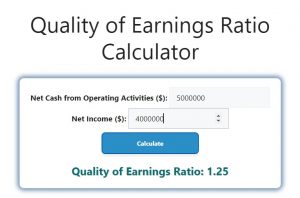About Quality of Earnings Ratio Calculator (Formula)
The Quality of Earnings Ratio (QER) is a crucial financial metric used to evaluate the reliability of a company’s earnings. It compares cash flows from operating activities with net income, providing insight into whether a company’s earnings are generated through core operations or through accounting adjustments. A high QER indicates high-quality earnings, while a lower ratio may suggest that earnings are less reliable or influenced by non-operational factors.
Formula
The formula to calculate the Quality of Earnings Ratio (QER) is:
Quality of Earnings Ratio (QER) = Net Cash from Operating Activities (NCO) / Net Income (NI)
Where:
- NCO is the net cash generated from operating activities.
- NI is the net income reported by the company.
How to Use
- Obtain financial data: Gather the company’s financial statement, specifically focusing on net cash from operating activities and net income from the income statement.
- Apply the formula: Use the formula by dividing net cash from operating activities (NCO) by net income (NI).
- Interpret the result: A QER greater than 1 indicates that the company’s earnings are supported by cash flows, while a ratio below 1 may suggest that earnings are inflated or influenced by non-cash items.
Example
Let’s assume a company has the following financial data:
- Net Cash from Operating Activities (NCO): $5,000,000
- Net Income (NI): $4,000,000
Using the formula:
QER = 5,000,000 / 4,000,000 = 1.25
This indicates that the company’s earnings are backed by sufficient cash flows, making them of high quality.

FAQs
- What is the Quality of Earnings Ratio?
The Quality of Earnings Ratio measures the reliability of a company’s earnings by comparing its cash flow from operations to its net income. - Why is the QER important?
It helps investors and analysts assess whether a company’s earnings are generated through core operations or influenced by accounting adjustments. - What does a QER greater than 1 mean?
A QER above 1 indicates that a company’s earnings are supported by actual cash flows, signaling high-quality earnings. - What does a QER below 1 suggest?
A QER below 1 may indicate that a company’s earnings are influenced by non-operational factors, making them less reliable. - Where can I find the data to calculate QER?
The required data (net cash from operating activities and net income) can be found in the company’s financial statements. - Can the QER change over time?
Yes, the QER can fluctuate due to changes in cash flows or net income, especially as operational conditions evolve. - What are common reasons for a low QER?
A low QER may result from non-cash accounting practices, such as depreciation, amortization, or significant changes in working capital. - How is the QER used by investors?
Investors use the QER to evaluate the sustainability and reliability of a company’s earnings, helping them make informed decisions. - Can a high QER indicate a strong business?
Yes, a high QER generally suggests that a company is generating sufficient cash from its core operations, indicating business strength. - Are there industry benchmarks for QER?
QER benchmarks can vary across industries, as different sectors may have varying levels of capital intensity and operational cash flow. - What is considered a good Quality of Earnings Ratio?
A QER greater than 1 is generally considered good, as it indicates that earnings are backed by cash flows. - Can the QER be negative?
Yes, a negative QER occurs when a company has negative cash flows or net income, signaling financial instability. - Does the QER reflect profitability?
The QER does not directly measure profitability, but it indicates the quality and sustainability of reported profits. - How does depreciation affect the QER?
Depreciation reduces net income but does not impact cash flow, which can lead to a higher QER in companies with significant depreciation. - How does the QER relate to earnings quality?
A higher QER is a direct indicator of better earnings quality, as it shows that earnings are supported by operational cash flow. - Can a company manipulate its QER?
While difficult, companies can influence their QER by adjusting their working capital or recognizing revenue at different times. - What’s the difference between QER and profit margin?
Profit margin measures profitability, while QER assesses the quality and sustainability of those profits based on cash flow. - How often should the QER be calculated?
It is typically calculated quarterly or annually, in line with the release of financial statements. - Can the QER be used in conjunction with other financial ratios?
Yes, the QER can be used alongside profitability ratios, liquidity ratios, and other metrics to give a comprehensive view of financial health. - What are some limitations of the QER?
The QER may not fully account for industry-specific factors or one-time cash flow events, so it should be used with other analyses.
Conclusion
The Quality of Earnings Ratio is a valuable tool for investors, analysts, and financial professionals to assess the reliability of a company’s earnings. By comparing net cash from operating activities to net income, the QER reveals whether earnings are truly generated from core operations or influenced by accounting practices. A high QER is a sign of financial strength, while a low QER may prompt further investigation into a company’s financial health.